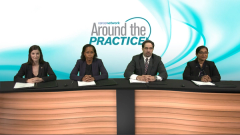
Role of Transplant in Multiple Myeloma
Clinical experts examine the role of transplant in multiple myeloma and discuss key clinical trials and the impact of adding daratumumab to triplet therapy.
Episodes in this series

Transcript:
Al-Ola Abdallah, MD: Nausheen, there have been a lot of trials for stem cell transplant. I’ll be honest: transplant has been the standard of care. Nobody in this room would disagree with that. [Based on] the last trials we saw, like when they compared the GRIFFIN trial, we’re going to do RVd [lenalidomide, bortezomib, dexamethasone]–transplant vs daratumumab–RVd [lenalidomide, bortezomib, dexamethasone]–transplant. But transplant is the main thing. There are other trials and a lot of questions. If there’s no overall survival benefit from the transplant, can we drop the transplant and use it, especially in standard-risk [disease]? We have the DETERMINATION, IFM 2009, and FORTE trials. Can you give us your input? You do a lot of transplants for myeloma. What’s the rule of transplant now, especially with these studies?
Nausheen Ahmed, MD: Thank you, Abdullah. We do transplants at many institutions. Nationally, we still have up-front transplant as a standard of care, and it’s based on the IFM 2009 trial, which randomized patients to get RVd [lenalidomide, bortezomib, dexamethasone] followed by maintenance or RVd [lenalidomide, bortezomib, dexamethasone] with transplant and then maintenance. There was a progression-free survival [PFS] advantage for those who got a transplant. It was a 1- to 2-year difference, which is pretty significant in the long run for patients with myeloma.
More recently, the results of the DETERMINATION trial were published in NEJM [New England Journal of Medicine], which had 2 arms: an arm with RVd [lenalidomide, bortezomib, dexamethasone] induction followed by transplant and then maintenance vs induction followed by maintenance, which would continue to progression. There was a good number of patients, 300-plus in each arm. In that study, the patients who didn’t get the transplant had a PFS of around 3 years. In the other arm, in the ones who had transplant, it was 5 to 6 years. You’re seeing a 2-year difference in PFS.
I agree that we haven’t seen an overall survival difference, but that’s probably because patients in both the groups are going to do well for a long time. We haven’t had the chance to capture that difference. We’ll see how things roll out. But given the data we have, this is still standard of care.
Al-Ola Abdallah, MD: I agree. We also have to agree that a high-risk myeloma transplant is where we need to push for [this]. This is a fit patient in his 40s. Talking about PFS, I prefer to get longer PFS for this patient.
Jordan, we’ve talked about the GRIFFIN trial. We have 4 drugs, including daratumumab. We feel comfortable with RVd [lenalidomide, bortezomib, dexamethasone] and transplant. Nausheen talked about how transplant is still the standard of care. We still have to do it. There was always a concern that about if you had a fourth drug, like daratumumab, will that impact the stem cell collection for the patient? That’s a common question that we’ve been getting. Any comments about that?
Jordan Snyder, PharmD: The addition of daratumumab to RVd [lenalidomide, bortezomib, dexamethasone] in the GRIFFIN trial resulted in numerically fewer stem cells collected, but it didn’t seem to have an effect on the ability to cryopreserve for additional transplants should a patient need it. It’s important to note that they did require more plerixafor up front vs patients who received only RVd [lenalidomide, bortezomib, dexamethasone], which can increase costs and adverse effects for these patients. As far as adverse effects go, adding daratumumab to RVd [lenalidomide, bortezomib, dexamethasone] resulted in higher rates of cytopenias, particularly neutropenia and thrombocytopenia. [There were] higher rates of infection, but when we look at grade 3/4 infections between the treatment arms, they were pretty similar. For patients who received daratumumab, the majority of infections were mild and able to be managed pretty easily.
Al-Ola Abdallah, MD: I agree. One important thing is to look at the benefit of adding a drug and whether it can overcome any adverse effects from the treatment.
Transcript edited for clarity.
Newsletter
Stay up to date on recent advances in the multidisciplinary approach to cancer.



















































































